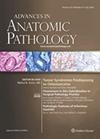新辅助治疗后手术切除肺癌的病理学研究
IF 2.6
2区 医学
Q1 PATHOLOGY
引用次数: 0
摘要
约有 30% 的非小细胞肺癌患者被诊断为晚期但可切除。在局部晚期疾病中,增加全身治疗比单纯手术治疗有明显优势,目前,辅助或新辅助化疗免疫疗法是治疗无靶向突变患者的新标准。新辅助治疗方法的一大优势是可以立即评估治疗效果,这凸显了病理学在临床决策和研究前沿的重要作用。本综述总结并更新了新辅助治疗后治疗效果组织学评估(也称回归分级)的现行指南,并讨论了一些新数据,重点关注不断变化的问题和争议领域,如肿瘤和瘤床的大体检查、加权与非加权评估方法、主要病理反应的特定肿瘤类型组织学临界值讨论、淋巴结评估以及免疫治疗和靶向治疗后的回归分级。由于目前还没有关于多发肿瘤结节回归分级的数据或建议,因此建议采用实用的方法。最后,我们将介绍更多的组织生物标志物,并总结在利用循环肿瘤 DNA 评估治疗反应这一讨论热烈的领域中的最新进展。本文章由计算机程序翻译,如有差异,请以英文原文为准。
Pathology of Surgically Resected Lung Cancers Following Neoadjuvant Therapy.
In around 30% of patients, non-small cell lung cancer is diagnosed at an advanced but resectable stage. Adding systemic therapy has shown clear benefit over surgery alone in locally advanced disease, and currently, chemo-immunotherapy in the adjuvant or neoadjuvant setting is the new standard for patients without targetable mutations. One major advantage of the neoadjuvant approach is the possibility of an immediate evaluation of the treatment effect, highlighting the role of pathology as an important contributor at the forefront of clinical decision-making and research. This review provides a summary and an update on current guidelines for histological evaluation of treatment effect after neoadjuvant therapy, also known as regression grading, and discusses newer data focusing on areas of evolving questions and controversies, such as the gross examination of the tumor and tumor bed, weighted versus unweighted evaluation approaches, discussion of histologic tumor type-specific cut-offs for major pathologic response, assessment of lymph nodes and regression grading after immunotherapy and targeted therapy. As no data or recommendations exist on regression grading of multiple tumor nodules, a practical approach is recommended. Lastly, we will touch on additional tissue biomarkers and summarize recent advances in the ardently discussed field of using circulating tumor DNA for the evaluation of treatment response.
求助全文
通过发布文献求助,成功后即可免费获取论文全文。
去求助
来源期刊
CiteScore
10.30
自引率
3.00%
发文量
88
审稿时长
>12 weeks
期刊介绍:
Advances in Anatomic Pathology provides targeted coverage of the key developments in anatomic and surgical pathology. It covers subjects ranging from basic morphology to the most advanced molecular biology techniques. The journal selects and efficiently communicates the most important information from recent world literature and offers invaluable assistance in managing the increasing flow of information in pathology.

 求助内容:
求助内容: 应助结果提醒方式:
应助结果提醒方式:


